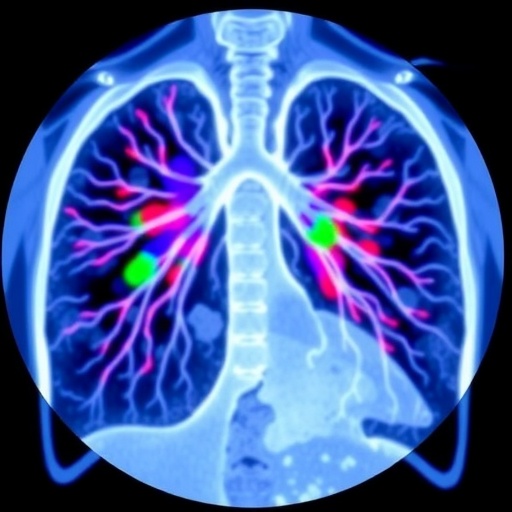In a groundbreaking advancement at the intersection of artificial intelligence and pulmonary medicine, researchers have engineered a novel pathomics-based machine learning model aimed at radically improving the diagnostic precision of LungPro navigational bronchoscopy in detecting peripheral lung lesions. This retrospective study harnesses state-of-the-art computational techniques to amplify diagnostic accuracy, potentially reshaping how clinicians approach lung cancer detection and management.
LungPro navigational bronchoscopy, a minimally invasive imaging-guided technique, is critical for diagnosing peripheral pulmonary lesions, which often pose formidable diagnostic challenges due to their subtle presentation and complex anatomical locations. Despite notable progress in bronchoscopic technologies, conventional LungPro biopsy procedures occasionally yield false negatives, leaving some malignant lesions undetected and complicating timely therapeutic interventions.
Addressing this clinical gap, scientists collected comprehensive datasets consisting of clinical parameters and meticulously annotated hematoxylin and eosin (H&E) stained whole slide images (WSIs) from a cohort of 144 patients who underwent LungPro virtual bronchoscopy within a two-year window from 2022 to 2023. This extensive repository provided an unprecedented foundation to explore intricate microscopic tissue patterns linked to malignancy using artificial intelligence frameworks.
Central to the study is the development of an innovative convolutional neural network (CNN) utilizing weakly supervised learning techniques to extract nuanced image-level features from the WSIs. Unlike traditional fully supervised models, this approach capitalizes on partially labeled data, enabling the capture of rich, context-dependent histopathological signatures without exhaustive manual annotations. These image features were subsequently integrated into a multiple instance learning (MIL) strategy that aggregates patient-level information, facilitating robust predictive modeling.
Complementing the image-based analytics, logistic regression identified pivotal clinical and radiographic risk factors including patient age, lesion boundary characteristics, and mean computed tomography (CT) attenuation values. These variables independently correlated with malignancy risk, underscoring the importance of multimodal data fusion in enhancing diagnostic performance beyond singular data domains.
The resulting pathomics machine learning model demonstrated remarkable diagnostic capabilities. In the training cohort, the model achieved an area under the curve (AUC) of 0.792, while in the independent test cohort, it maintained a robust AUC of 0.777. These metrics underscore a consistent ability to discriminate malignant from benign peripheral lung lesions, rivaling or surpassing current diagnostic tools used in clinical practice.
Importantly, the multimodal diagnostic framework, which synthesizes clinical features with pathological image data, further elevated diagnostic accuracy, achieving an impressive AUC of 0.848. This integrative approach not only refines lesion characterization but also addresses limitations posed by isolated imaging or clinical assessments, emphasizing the synergy between diverse data modalities.
One of the most clinically significant aspects of this model is its application in LungPro biopsy-negative cases. Here, the algorithm identified 20 out of 28 malignant lesions with a sensitivity of 71.43% and correctly classified 15 out of 22 benign lesions with a specificity of 68.18%. These figures highlight the model’s potential as a powerful adjunct tool to detect occult malignancies initially missed by traditional biopsy techniques.
The research team also employed class activation mapping (CAM) to interpret the AI’s decision-making process. CAM visualizations pinpointed hallmark malignant histopathological features such as prominent nucleoli and nuclear atypia within tissue samples. This transparency reinforces trustworthiness in AI-assisted diagnostics by linking predictive outcomes to biologically meaningful features readily recognized by pathologists.
From a broader perspective, this fusion diagnostic model exemplifies the transformative power of pathomics and machine learning to unravel complex disease phenotypes from digital pathology images. By extracting and integrating minute morphological details that escape human perception, this approach heralds a new era of precision medicine for lung cancer diagnosis and beyond.
Clinicians stand to benefit immensely from these insights, as improved diagnostic accuracy facilitates more targeted therapeutic strategies and individualized patient management. Early and accurate detection of malignant peripheral lung lesions can markedly improve survival outcomes, optimizing resource allocation in healthcare and mitigating the burden of unnecessary invasive procedures.
This study also lays the groundwork for prospective validation and eventual clinical deployment of AI-powered LungPro-based diagnostic frameworks. Future research will be critical in evaluating real-world efficacy across diverse patient populations and integrating these models seamlessly into clinical workflows.
In conclusion, the pioneering work led by Ying, Bao, Ma, and colleagues introduces a sophisticated pathomics machine learning model that substantially advances the diagnostic accuracy of LungPro navigational bronchoscopy. By synergistically fusing clinical, imaging, and histopathological data, this model enhances detection sensitivity, particularly in challenging biopsy-negative cases, promising more precise and actionable clinical decision-making in the fight against lung cancer.
Subject of Research: Development of a pathomics-based machine learning diagnostic model to optimize LungPro navigational bronchoscopy for peripheral lung lesion assessment.
Article Title: Pathomics-based machine learning models for optimizing LungPro navigational bronchoscopy in peripheral lung lesion diagnosis: a retrospective study.
Article References:
Ying, F., Bao, Y., Ma, X. et al. Pathomics-based machine learning models for optimizing LungPro navigational bronchoscopy in peripheral lung lesion diagnosis: a retrospective study. BioMed Eng OnLine 24, 107 (2025). https://doi.org/10.1186/s12938-025-01440-2
Image Credits: AI Generated
DOI: https://doi.org/10.1186/s12938-025-01440-2
Tags: artificial intelligence in lung cancer detectionconvolutional neural networks in healthcareenhancing diagnostic precision for lung lesionsfalse negatives in bronchoscopy procedureshematoxylin and eosin stained imagesimproving therapeutic interventions for lung cancerLungPro navigational bronchoscopy accuracymachine learning in pulmonary medicineminimally invasive imaging techniquespathomics-based diagnostic modelretrospective study on lung diagnosticsweakly supervised learning in medical imaging





